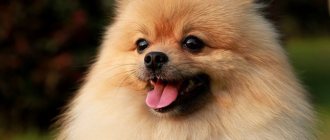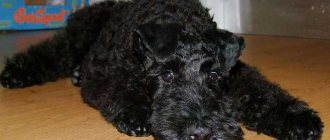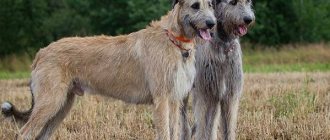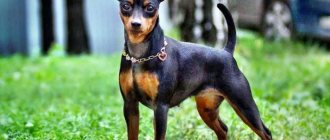Description of the Prague Rat breed
Popularity 44th among 263 dog breeds
Lifespan:
12-14 years old
Breed group:
Decorative
Height:
19-23 cm
Country of origin:
Czech
Average price:
30-40 thousand rubles
Weight:
2-2.2 kg
Latest articles Cat health
Ataxia in cats: what it is, how it manifests itself and is treated 01/23/2022 151 0 0
Cat health
Leukemia, or viral leukemia in cats 01/23/2022 140 0 0
Advantages and disadvantages
- Pros:
- intelligence, devotion, getting along with other pets;
- the dog is suitable for living in a small apartment;
- courage, lack of fear of larger dogs;
- good health, no predisposition to genetic diseases;
- omnivorous, simple daily care.
- Minuses:
- are obese;
- need for attention and communication;
- tendency to colds;
- weak bones that can break when falling from a height;
- make “stashes” throughout the house.
Toy Terrier
Description
This is a small dog whose height reaches 20-28 cm and weight 2-3 kg.
Morphologically, the sexual type is weakly expressed, but not in the behavior of animals. The dogs have a square body shape, large ears and round, protruding eyes. The tail is often docked (up to 2-3 vertebrae).
Read more about what Toy Terriers look like here.
Advantages and disadvantages
Positive sides:
- mind;
- love of life;
- devotion;
- distrust of strangers;
- good relationships with family;
- suitable for keeping in an apartment;
- moderate appetite;
- able to cope without long walks.
Negative:
- hysterical character;
- excitability;
- tendency to obesity;
- susceptibility to disease;
- cunning and ability to manipulate (they are often challenged for the right to lead);
- miniature;
- short life expectancy.
Character
This is an energetic breed, which is not without temper and mischief, which often attracts trouble..
Therefore, indecisive owners have problems trying to curb the animal’s temperament. Moreover, the toy terrier is not without cunning, and natural charm serves as a means to achieve goals.
So don't be surprised if the dog decides to challenge its owner's leadership.
Do not forget that upbringing largely determines character .
Key facts
Czech, or Prague rat rats are small dogs, reaching 19-23 centimeters at the withers, weighing 2.2 kilograms. According to the standard, the coat can be medium or short (such dogs are called smooth-haired) and yellow-red, brown, black-and-tan or bluish-tan.
Libeni serochki (another name) are energetic, incredibly active animals, moderately sociable and unobtrusive. The above characteristics make dogs the best friends for single people and large families.
Prague Rat Dogs are naturally dexterous and intelligent, are easy and quick to train, and are happy to carry out commands that are standard for service breeds.
The description of the Prague Ratdog breed combines:
- toy and pretty appearance;
- cheerfulness and energy;
- intelligence and courage;
- peaceful, good-natured disposition;
- loyalty, devotion to the breeder;
- ease of education and training.
The graceful baby willingly shares an inexhaustible supply of joy and love of life with family members. The clockwork nimble is ready to accomplish a real “feat” even during an ordinary walk on the street.
Characteristics of the Prague Ratdog breed include key factors:
- Country of origin: Czech Republic, Middle Ages. From historical sources it is known that dogs were very popular during the reign of the Czech king Charlemagne. He received a puppy as a gift from the King of France in honor of the signing of the peace agreement.
- Character traits – animals are active, adventurous and intelligent. These qualities are inherent in nature - once upon a time, warriors were used to hunt cunning and nimble rats and mice. In everyday home environments, dogs behave calmly, do not raise their voices without reason, and prefer to always be close to their owner.
- With proper nutrition and daily maintenance, the life expectancy of the Prague rat rat is 12-14 years.
- Care does not take much time, effort and financial costs.
Ratliki apartments are ideal for living in a small city apartment, where the rule applies: “my home is my fortress.” Dogs are incredibly active, so before you bring them home, you need to close all the places in the rooms where they can climb, get hurt, or get stuck. Care should also be taken to ensure that there are no high places from which the dog can jump and injure weak limbs.
The nimble and playful Czech rat loves long walks outside, and in cold weather he will need warm clothes to prevent the animal from freezing.
Comparison
Differences from the Toy Terrier
The Czech Ratlik is sometimes confused with other toy breeds, such as miniature pinscher, toy terrier or chihuahua. They are actually vaguely similar in appearance. But there are a couple of differences with the Toy Terrier. Toy Terriers are slightly taller than Prague Rat Dogs (their height reaches 30 centimeters at the withers) and have on average more weight (about 3 kilograms versus 2.6 for Prague Rat Dogs).
But these two breeds not only have external differences, they also behave completely differently. Rats are calmer and braver, they are ready to protect their owner at any moment. Toy terriers, on the contrary, are more cowardly and nervous.
Differences and similarities with the Russian Toy Terrier
The Ratlik is confused with the Russian Toy Terrier much more often, despite the fact that they differ even more.
| Prague rat | Russian toy terrier |
| more muscular and stronger physique | weak and fragile physique |
| height reaches 24 centimeters | height reaches 28 centimeters |
| elongated muzzle | less elongated muzzle |
| energetic temperament, adventurer, protector | decorative dog |
The history of the origin of the Prague Rat
Ratliks gained the greatest popularity in Prague in the Middle Ages. Their demand was due to the negative attitude of church ministers towards cats and cats, the mass extermination of which led to the filling of cities and villages with rodents and, as a consequence, widespread unsanitary conditions. To tame the mouse mess, breeders began breeding a special breed of dog capable of hunting rodents and other small animals. The result of the work was the appearance of the first warriors, who settled in the chambers of Prague aristocrats.
For a long time, the Liben serochki remained local celebrities, their fame did not go beyond the borders of the state. But in the 8th century, thanks to the Frankish scientist Einhard, all of Europe learned about brave animals. In 1377, Charles of Luxembourg presented the Prague rats as a gift to the French king Charles the Fifth.
The famous legend about the special duty of dogs dates back to this time - they were entrusted with the role of “tasters” of food for representatives of the nobility, who at that time were often poisoned. An interesting fact has been preserved in history: how the tavern-loving King Wenceslas the Fourth, when going “to the people,” always took a small rat with him. While present at the royal Sabantui, the dog walked freely around the tables, taking turns “tasting” the dishes and demonstrating that the food was not poisoned.
At the beginning of the 17th century, the Czech Republic was in decline, and the warriors were gradually forgotten. From luxurious boudoirs they move to damp barns, where they catch rats and mice. Enthusiast cynologists tried to revive the famous breed of dogs in the 19th century, but the First and Second World Wars brought their work to naught. The next, already successful attempt to revive the famous breed was made in the 20th century by Schiller and Findeis.
The first registration of the miniature breed was carried out in 1980. After that, Ratlik breeding was carried out exclusively by Czech and Slovak breeders. Since 2000, the breed has spread throughout the world. Today there are about three thousand Libeni chamois.
Similar dog breeds
Jack Russell Terrier
Scottish Terrier
West Highland White Terrier
Russian toy terrier
Appearance of the Prague rat rat
General impression
As you can see in the photo, the Prague rat is a small “aristocrat”, similar to a miniature pinscher or Russian toy.
Professional breeders pay special attention to the proportions of the dogs’ fragile body: a calculator and a ruler allow you to determine an exemplary representative. Thus, the ideal ratio of animal height to body length is 1 to 1.05.
In this case, the number that indicates the height of the dog at the withers should be twice the depth of the sternum. The ratio of forehead width to length should be one to one, sometimes 1 to 1.04, and the size of the Prague rat's muzzle cannot exceed half the length of its head.
Head
The head is small, pear-shaped, the forehead is convex, and has a clear dividing groove. If you look at the head from above, the forehead will be square; the breed standard allows for a slight elongation from the back of the head to the nose, but it cannot exceed 2% of the width.
There are no skin folds on the forehead and muzzle, the cheekbones are “dry”, the arches above the eyebrows are well defined, not convex. The U-shaped muzzle is slightly blunted, with a flat back of the nose.
The eyes are round and dark in color. The ears are set wide, in a standing position, and from the side they resemble “butterfly wings.” The standard allows, but does not recommend, placing the tips of the ears at a slight angle to one another.
Neck
Medium in thickness, without skin folds, has a noble curve.
Torso
In males it is square, in females there is a slight elongation due to reproductive function. The withers are weakly expressed. The back is muscular and straight. The loin is quite strong and thick. The croup is slightly elongated, with a slight slope and a tightened groin line.
Front and hind limbs
The paw placement is barrel-shaped. The shoulder blades fit well to the body, the muscular, even pasterns are set at a slight angle. The paws are arched, rounded, the toes are tightly pressed.
Tail
The tail of puppies is docked or remains at a natural length. In a calm state, it falls down, and when the animal shows interest or moves, the tail outlines a semicircle in the air above the back or rises above the line of the spinal column.
Movement
Springy, quite loose. Czech rat rats are incredibly nimble, they love long walks and active games on the playground.
Wool
Ratliks come with short or semi-long hair. In the first case, the cover is quite dense and fits well to the body. In the second, it is softer, slightly behind the body, and forms beautiful feathering on the ears, tail, and limbs.
Prague rat rat colors
Most of the elite breed are brown and tan or completely black. Sometimes there is a chocolate, sandy color. A marble tone is also acceptable. Marks are found on the throat, cheeks, chest, thighs, and pasterns.
Prague Rat Size
The height of the Prague rat rat reaches 23 centimeters at the withers. The weight of the Prague rat rat in adulthood is 2.2-2.3 kilograms. The standard sets the limit at 2.4 kg.
Main disqualifying characteristics of the breed:
- hair with receding hairline;
- poorly overgrown fontanel;
- incorrect position of teeth:
- too convex lower back;
- hunched back;
- drooping ears;
- blue or yellow eye color;
- absence of white markings on the chest and paws of brown and tan and completely black dogs;
- height at the withers is less than 17 or more than 25 centimeters;
- cowardly character, unreasonable aggression.
Other inconsistencies of the breed are identified: excess tan, narrow skull, light spots on the chest and limbs more than 1 centimeter, too elongated body, elbows turned inward or outward, tail that “falls” to the side or is low-set.
Distinctive features
The main distinguishing characteristics of the Prague rat rats are:
- General form. A small dog of almost square format (extension index for males is 100 to 105, for females 100 to 110), agile and active.
- Head. Small, proportional to the body, pear-shaped, dry. The forehead is moderately wide, the cheekbones do not protrude, and the brow ridges are well defined. The transition from the forehead to the nose is significantly pronounced. The ears are set high and wide apart, triangular in shape. The eyes are large, round, widely set, dark (almost black).
- Muzzle. Narrow, smooth, slightly longer than the skull. From the nose to the forehead it widens slightly. The bridge of the nose is slightly turned up or straight. The nose is small, pigmented black or similar to the main color. Scissor bite. Teeth set – 42 pieces.
- Neck. Lean, muscular, slightly elongated and curved, without dewlap. The transition from the neck to the back (withers) is poorly defined.
- Frame. The shoulder blades are muscular, set obliquely. The chest is broad, falling below the elbows, with moderately sprung ribs. The back is straight, without sagging, strong. The stomach is significantly tucked in. The loin is rounded and short.
- Tail. Set low, carried above the level of the back. Long above the hock or docked to the third vertebra.
- Limbs. The limbs are parallel to each other, the pasterns are gathered into a ball, the hock joints have pronounced angles.
- Sexual dimorphism. Moderately expressed, females are smaller and lighter than males (welcome).
Character of the Prague rat rat
Ratlik is a miniature “comforter”, overly devoted to his owner, capable of creating a favorable environment in the home. This “antidepressant” is endowed by nature with a good mind and abilities: the little rat never imposes itself, does not express dissatisfaction with grumbling or loud barking.
The dog is wary of strangers, but he will definitely approve of a noisy and fun party with many guests. The most important thing is to find time to introduce him to the guests who have come.
The Prague Rat Dog's character is soft and accommodating; the animal gets along well with small children and other pets, but does not get along well with large dogs. At the same time, it is difficult to frighten warriors with physical superiority - if a small pet is provoked by a shepherd dog, he will rush at her with the same pressure as he would attack an ordinary rodent. As for rats and mice, this is goal No. 1 for a small animal, so you shouldn’t let your dog off the leash while walking.
The Prague warriors are not without egoism. The small size at first confuses and makes you see pets as weak-willed babies, suitable for decorating interior decoration and constantly being carried in your hands. In fact, behind the cute appearance lies a serious and self-sufficient personality that demands respect.
It is worth immediately weaning children from encroaching on the rat's personal and favorite things. From puppyhood, they perfectly understand the meaning of the word “mine” and vigilantly monitor personal belongings, coming into conflict with anyone who tries to take them.
FCI recognition
The breed standard was registered in the Czech Republic in 1980 with its first official representative. Modern Czech cynologists continue to restore the breed and apply for recognition by the International Canine Federation (FCI). At the same time, many large organizations involved in cynology have already recognized the Prague Rat Dog, having included a description of the breed in their registers. The instability of the standard currently creates loopholes for unscrupulous producers, but when the breed is recognized by the FCI, the rules will be tightened.
Education and training
You should start raising your baby from the first days of being in the house. Ratliks love to dominate, so if you don’t set your own rules right away, they will easily sit on your neck. It is important that until the age of 7 weeks the puppy is close to the mother dog and his brothers - during this time he builds relationships with people and develops an understanding of his place among other dogs.
Otherwise, Prague Rat Dogs are miniature lap dogs that love tasty gifts, encouragement, and outright flattery. If you want to teach them something useful, you shouldn’t skimp on compliments and affection. There is no need to physically punish an animal for wrongdoing - this can cause injury to a fragile pet and forever discourage it from cooperating with you.
Remember that dogs sense the emotional mood of the owner very well - if you give in, they will happily take advantage of it and turn it to their advantage. Take a positive approach to raising and training the Prague Rat, but do not pamper your pet too much, so as not to be upset later because of destruction and minor mischief.
The most suitable for a ratnik is a general training course. After training and instilling the basics of etiquette, dogs do not cause much trouble when walking. The Libeni chamois also have a talent for sports disciplines. They are good at catching up (coursing) and obedience standards (obedience).
Owner reviews
Anna, Dobby's owner (4 years old) writes:
«Dobby was given to me by my children. When I first saw him, I realized that this was love for life! He and I are practically inseparable - he really loves to accompany me on walks and trips to the store. I used to be very biased towards small dogs - my relatives have a terrier who tormented the whole family with incessant barking! Dobby is quiet and calm."
Julia, Max's owner (1 year old) writes:
“All my life I kept Dobermans and then I got a Ratlik puppy. He touched me so much - a real small copy of a Doberman, who is not aware of his tinyness. He begins to growl at uninvited guests, and sometimes rushes into a fight with dogs that are ten times larger than him. I won’t lie, this causes inconvenience on walks and puts me in an awkward position. My neighbors have a Newfoundland, which my Max for some reason doesn’t like, and as soon as he sees him, he rushes barking at the poor giant who doesn’t understand anything.”
Oleg, owner of Shelley (6 years old) writes:
“Shelley, this is a baby who considers herself a thunderstorm and the mistress of the yard. Everyone barks – from passing cars to the neighbors’ dogs. A very nervous and wayward breed.”
Alla, owner of Lassie (2.5 years old) writes:
“Lassie, this is my second Prague Rat dog. She is the ideal friend and companion. He doesn’t impose himself if he sees that I’m busy, but at the same time he always joins in the game with enthusiasm, you just have to call me. She simply adores children. Doesn't hurt the cat. I got used to the litter tray and going outside without any problems.”
Valery, owner of Chuck (4 years old) writes:
«A breed full of enthusiasm and curiosity. Prepare for the appearance of a rat in the house as for the appearance of a small child. Be sure that all dark and dusty corners will be explored, and doors that are not tightly closed will be opened. He loves to jump on furniture and if he doesn’t calculate the height, he can break his paw. It gets very cold, so buy warm down jackets for the winter in advance.”
Health and diseases of the Prague rat rat
Representatives of the miniature breed rarely suffer from any serious illnesses. This is due to the fact that they were rarely crossed with other breeds, without interfering too much with the breeding process.
Possible diseases
A small dog does not mean a frail dog. The little rat is cheerful and playful, and his health is good. However, there is always the possibility of illness. The following pathologies are usually observed in rat rats:
- Diseases of gums and teeth
– a stone often forms on them, which causes an unpleasant odor from the mouth. For prevention, you need to brush your pet’s teeth with a brush and a special paste, and regularly visit the veterinary clinic for plaque removal.
- Fractures
– due to the fragility of the bones of the forearms and limbs, they are injured after a jump from a height of more than 1.5 meters or a strong blow.
- Musculoskeletal problems
– Dislocation of the knee cap often occurs in dogs. This problem is usually inherited and is congenital.
- Gastrointestinal diseases
– the cause is common overeating, so the breeder should carefully monitor the amount of food consumed by the pet.
- Cold
– due to their short hair, dogs get cold in the cold season, they need to be dressed in clothes that will protect them from the wind and sub-zero temperatures.
Most of the above problems can be prevented if you properly care for your pet. In order to strengthen the rat's immunity, vaccination is recommended to avoid the occurrence of diseases such as hepatitis, rabies, distemper, leptospirosis and others.
Within 12 months, the dog receives all necessary vaccinations: at the age of 1.5-2.2 months, after 2 weeks and at 7-8 months. 10 days before this, the animal is given antihelminthic drugs. By the time of vaccination, the animal must be completely healthy!
Since ratliks are prone to colds, they should be carefully protected before the vaccination procedure, drafts should be completely eliminated, after bathing they should be thoroughly dried, blow-dried, and when walking, put on clothes. Immunity is developed 9-16 days after the vaccine is administered. At this time, excessive physical activity and communication with foreign animals are contraindicated for the pet.
Reproductive health
The Prague rat rat reaches sexual maturity at the age of 1.5 years. A bitch's heat is a sign that the owner can start looking for a suitable partner. But breeding miniature dogs is a rather complicated process. There are many nuances in this matter:
- There are about 3 thousand individuals of the miniature breed in the world, and to find a suitable pair for mating, you will have to try. Often you have to travel to another country, which will entail significant material costs.
- Breeders recommend crossing dogs of the same color, but finding such a male and female is very difficult. The culling of a large number of puppies from a litter is due to this very problem.
If a pair can be found, mating should be performed on the 11-12th day of estrus. Before this time, the future “parents” should get to know each other, which will make the reproduction procedure easier and avoid many problems. If the dogs are unfamiliar, it is better to let them walk together for about an hour, and then start mating.
Typically, pregnancy proceeds calmly and takes about 7 weeks. But childbirth is difficult and requires the intervention of a veterinarian. In case of complications, a caesarean section is performed.
If you did not take the animal for breeding, castration and sterilization are indicated: surgical intervention removes the testes of the male, and the ovaries of the female. After which the sexual desire completely disappears, and the animals become docile, affectionate and obedient.
Mating
According to the regulations “On Breeding Work” of the Russian Cynological Federation , individuals who have reached the age of 18 months are allowed for breeding . In females, breeders focus on the third heat, which in small dogs usually occurs closer to two years. Potential parents must be vaccinated, wormed and completely healthy.
The mating day is scheduled for the 10th – 14th day of estrus; deviations of 1 – 2 days in both directions are acceptable, depending on the physiology of the female. A day after fertilization, a double mating is carried out to give breeders complete confidence in pregnancy.
Multiple pregnancies are rare for dwarf breeds; normally, ratliks have litters of 2–4 puppies.
Read a detailed article on the topic: “Everything you need to know about breeding dogs: appropriate age, what to do if it doesn’t work out, rules and tips.”
Features of feeding and diet
Czech ratliks are unpretentious eaters and have an excellent appetite. To prevent the animal from becoming obese, food must be given in doses and at a certain time. It is recommended to use natural products or dry balanced food. Menu planning should be entrusted to a veterinarian.
It is forbidden to give the dog:
- fat meat;
- raw and river fish;
- sweets and baked goods, grapes and raisins;
- smoked, salted and spicy foods;
- salt, seasonings;
- milk;
- legumes;
- mushrooms;
- tubular long bones.
It is recommended to feed the ratlik:
- Beef, white meat chicken, rabbit. It is better not to give the meat raw to avoid intestinal parasites; small pieces should be boiled.
- Buckwheat and rice, which are cooked without spices and salt.
- Raw, boiled, baked vegetables.
- Fruits.
- Fresh greens.
- Offal.
- Occasionally yogurt, kefir and low-fat cottage cheese.
- Baked, boiled fish without bones.
Dry food should be premium from well-known manufacturers. The dog should always have fresh and clean water in his bowl. Mixing natural food and industrial feed is not recommended!
Care and maintenance
Ratlik prefers to always be near a person; for him, a home is a reliable fortress. Before purchasing a puppy, you need to prepare the apartment: eliminate narrow openings where the baby can climb, hide computer and electrical wires, secure and block off surfaces higher than 0.5 meters from which the dog can jump and break bones.
Maintaining and caring for the Prague Rat Dog does not cause much trouble. The dog easily gets used to the tray, but you should not forget about street walks. It is better to introduce an animal to hygiene from puppyhood, which will avoid problems in the future.
Pets do not shed intensively, but despite their short fur, they require regular brushing with a soft brush. It is better to complete the process by polishing the coat with a piece of suede, after which the wool becomes glossy and shiny.
They bathe the dog in warm water in a draft-free room, using special shampoo and coat care products for washing.
The ratlik's ears are open, which is why the shells are often covered with particles of dirt and sulfur. It is better to examine them several times a week. If necessary, clean with a cotton swab soaked in lotion. It is better not to use cotton swabs - they can damage the delicate shell of the animal. The eyes do not require special care; they can be occasionally wiped with chamomile decoction.
Tartar often forms on the teeth, so they should be thoroughly cleaned every 5-8 days with a veterinary brush and toothpaste. It is recommended to start the procedure at 3 months of age. You cannot use regular toothpaste for this! For prevention, the pet is given chewing bones that clean the teeth.
Nails are trimmed as they grow and only when the dog does not grind them down on the asphalt while walking along the street. You can cut claws at home with special nail clippers.
Tips for choosing a puppy
You should only buy a Czech Ratlik baby from a specialized nursery, regardless of whether it will be used for breeding, take part in exhibitions, or delight household members with its cute and toy appearance. Only from an official breeder can you purchase a Prague Ratdog puppy that fully meets the standard in character and appearance.
If you are taking a ratlik into a family with children, opt for a larger four-legged specimen so that the child does not harm it during play.
Before purchasing you should:
- Familiarize yourself with the reputation of the official nursery and breeder - this will help you avoid buying a defective or sick baby.
- Study the pedigree of the parents.
- Carefully examine the dog - there should not be any bald spots on the body. A pear-shaped head should not look very small. All teeth must be present and the bite is correct. The baby should be moderately well-fed and well built. The area under the tail should be dry, the ears should stand upright, and the tail should not fall to the side.
- Observe the behavior for some time: a healthy dog is active, inquisitive, she happily makes contact, demonstrates her peaceful, sociable disposition immediately after meeting her.
To participate in competitions, you need to choose a beautiful, fine-boned “show class” baby, breeding - large and healthy dogs, a companion - anyone who comes to your liking.
How to choose a pet
Prague rat rats are a rare and quite expensive breed. Nurseries specializing in their breeding are concentrated in Europe. There are also registered breeders in Russia, but they are all located mainly in Moscow.
In order not to regret the purchase, you need to choose a ratlik puppy personally, and not based on photos and videos. Before you make your final decision, you should pay attention to the following criteria:
- presence of stamp and documents;
- compliance with the breed standard;
- behavioral characteristics;
- conditions of keeping the mother and puppies.
On a note. You should not buy a puppy with bald patches on the coat, cloudy eyes, incorrect movements and an overly large head. This may indicate the presence of congenital diseases.
How much does the Prague Rasarik cost?
Due to the difficulty of breeding, miniature dogs cannot be cheap! The minimum price for a Prague rat rat with a normal pedigree, all vaccinations and documents starts from 30 thousand rubles, and with an 80% probability it will be a pet-class puppy.
Animals without any external defects, which in the future will participate in exhibitions or breeding of elite breeds, are valued much more expensive - from 60 to 120 thousand rubles. Famous nurseries in Russia where you can buy a pedigree baby: “Galivas”, St. Petersburg, “Ratlik Blues”, Moscow, “Hermosso Canis”, Nizhny Novgorod, “Blue Noir”, Orenburg.
Do you like the article? 0











